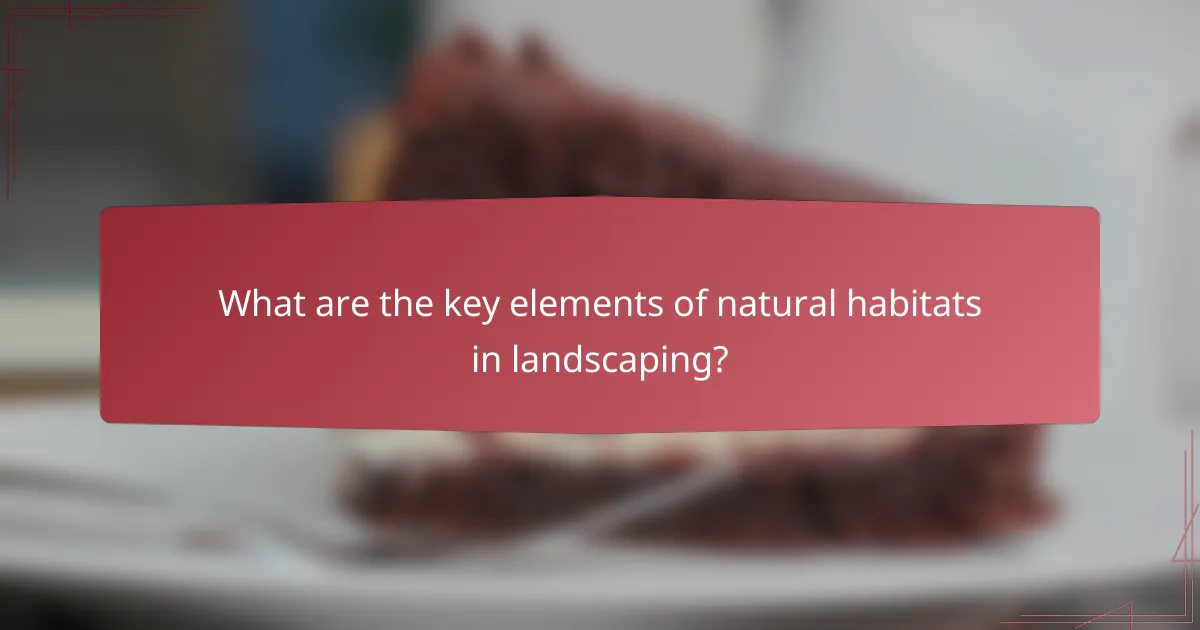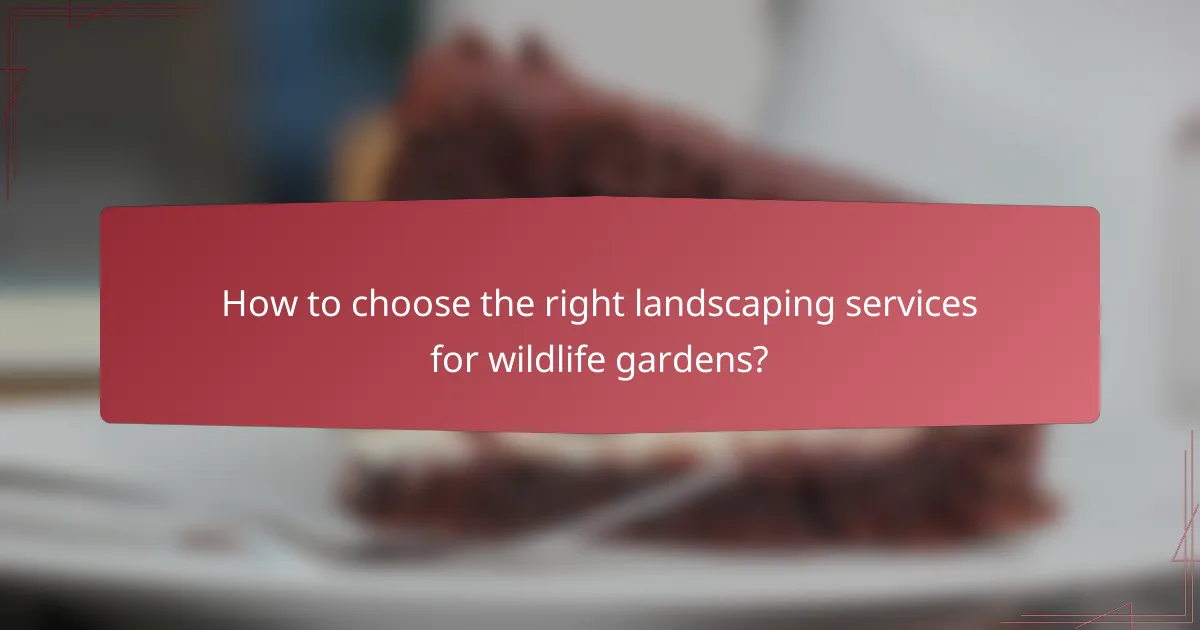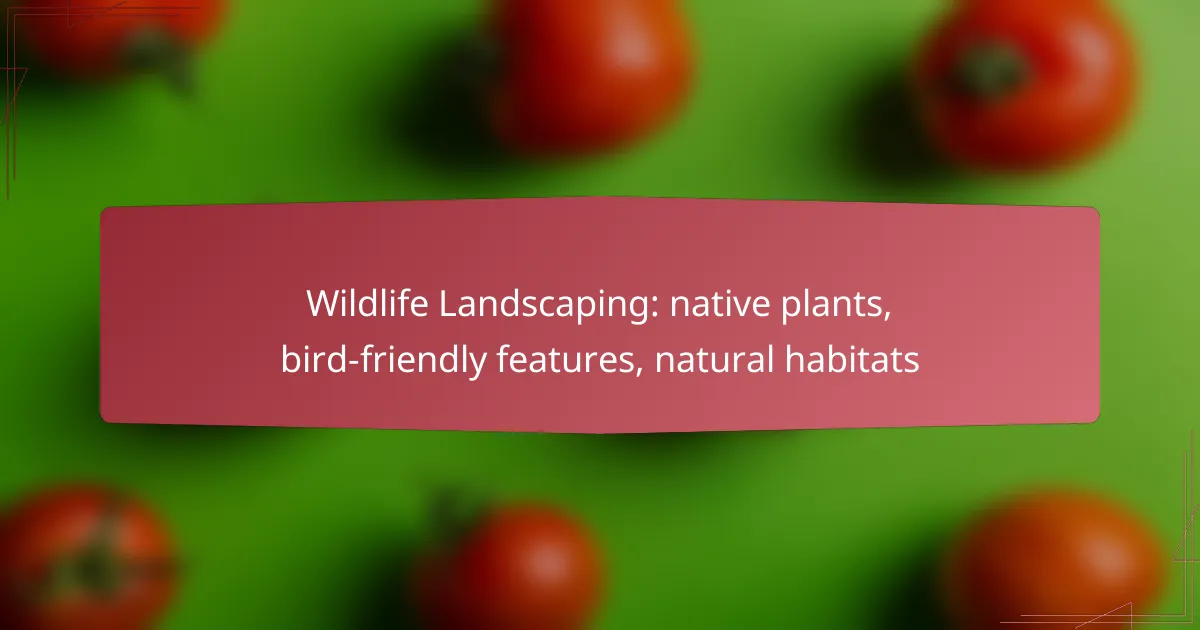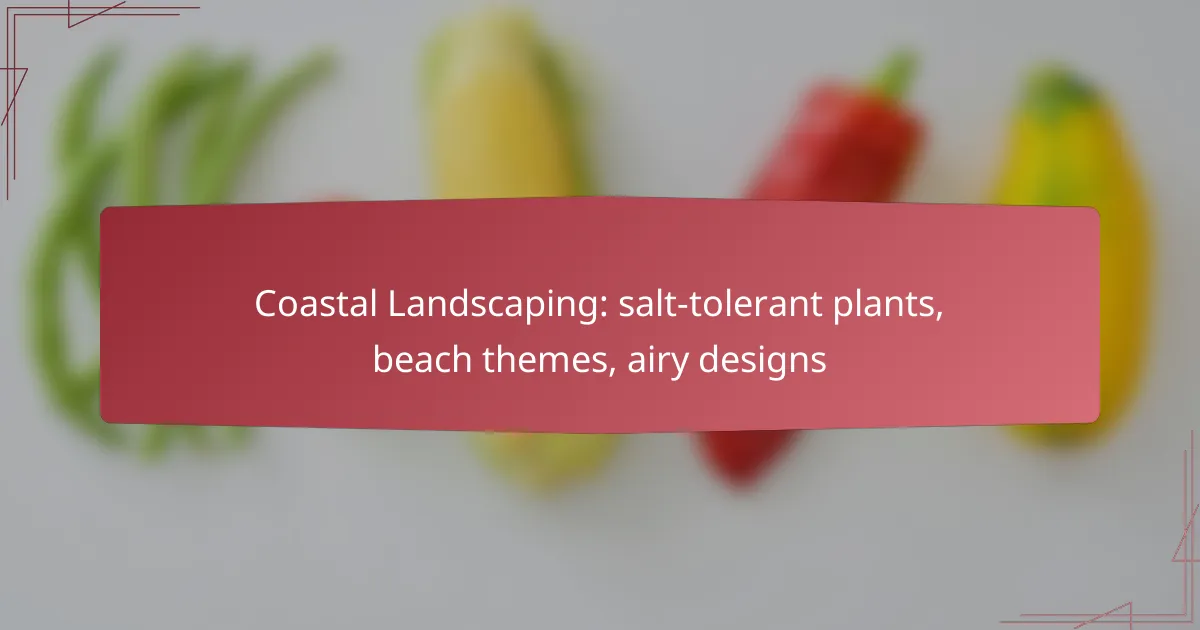Wildlife landscaping is a vital practice that fosters local ecosystems by integrating native plants and bird-friendly features into outdoor spaces. By selecting appropriate native species, homeowners can create inviting habitats that support diverse wildlife, promote ecological balance, and enhance the overall beauty of their gardens.

How can wildlife landscaping benefit local ecosystems?
Wildlife landscaping enhances local ecosystems by creating habitats that support diverse flora and fauna. By incorporating native plants and bird-friendly features, these landscapes promote ecological balance and sustainability.
Enhances biodiversity
Wildlife landscaping significantly enhances biodiversity by providing a variety of habitats for different species. Native plants attract a range of insects, birds, and small mammals, which contribute to a balanced ecosystem.
To maximize biodiversity, consider planting a mix of flowering plants, shrubs, and trees that bloom at different times throughout the year. This approach ensures that food sources are available for wildlife across seasons.
Supports native species
Using native plants in wildlife landscaping supports local species by offering food and shelter that non-native plants cannot provide. Native species are adapted to local soil, climate, and wildlife, making them more resilient and beneficial to the ecosystem.
When selecting plants, focus on those that are indigenous to your region. This not only helps local wildlife thrive but also reduces the need for chemical fertilizers and pesticides, promoting a healthier environment.
Reduces erosion
Wildlife landscaping helps reduce soil erosion by establishing deep-rooted native plants that stabilize the soil. These plants create a network of roots that hold the soil in place, preventing runoff and loss of nutrients.
To further combat erosion, consider incorporating features such as rain gardens or swales that capture and manage stormwater. These elements can effectively channel water while supporting diverse plant life, enhancing both functionality and aesthetics.

What native plants are best for wildlife landscaping in California?
California’s diverse ecosystems support a variety of native plants that enhance wildlife landscaping. Choosing the right native species can attract beneficial insects, birds, and other wildlife while promoting ecological balance.
California poppy
The California poppy is the state flower and a vibrant addition to any wildlife landscape. This hardy plant thrives in sunny areas and well-drained soil, making it ideal for gardens across the state.
California poppies attract pollinators such as bees and butterflies, contributing to the health of your garden. They are drought-tolerant, requiring minimal water once established, which is crucial for sustainable landscaping in California’s dry climate.
Manzanita
Manzanita is a versatile shrub known for its striking red bark and evergreen leaves. It provides excellent cover for birds and small mammals, creating a safe habitat for wildlife.
This plant thrives in poor, well-drained soils and is highly drought-resistant, making it suitable for low-maintenance gardens. Manzanita flowers attract hummingbirds and other pollinators, enhancing the biodiversity of your landscape.
Milkweed
Milkweed is essential for supporting monarch butterflies, which rely on it for breeding and feeding. Planting milkweed in your garden can help bolster declining monarch populations.
These plants prefer sunny locations and can tolerate a range of soil types, though they thrive best in well-drained conditions. Incorporating milkweed into your wildlife landscape not only supports butterflies but also attracts other pollinators, enriching your garden’s ecosystem.

How to create bird-friendly features in your garden?
Creating bird-friendly features in your garden involves incorporating elements that provide shelter, food, and water for birds. By focusing on these aspects, you can attract a variety of bird species and enhance your garden’s biodiversity.
Install birdhouses
Installing birdhouses is an effective way to offer nesting sites for birds. Choose birdhouses designed for local species, ensuring they meet size and entrance hole specifications suitable for the birds you want to attract.
Place birdhouses in quiet areas, ideally 5 to 10 feet off the ground, and avoid direct sunlight to protect the inhabitants from overheating. Consider using natural materials and avoiding treated wood to ensure safety for the birds.
Add water sources
Water sources are essential for attracting birds, as they need water for drinking and bathing. Install a birdbath or a small pond, ensuring the water is shallow enough for birds to safely access.
Keep the water fresh and clean by changing it regularly, ideally every few days. Adding a small fountain can help keep the water circulating, which not only attracts birds but also prevents stagnation.
Use native shrubs
Native shrubs provide food and shelter for birds, making them a vital component of a bird-friendly garden. Select shrubs that produce berries or seeds that are favored by local bird species.
Plant these shrubs in clusters to create a natural habitat that offers cover from predators. Aim for a mix of flowering and fruiting shrubs to ensure year-round support for birds and other wildlife.

What are the key elements of natural habitats in landscaping?
Natural habitats in landscaping focus on creating environments that support local wildlife and promote biodiversity. Key elements include native plant selection, wildlife corridors, and the use of natural mulch and compost.
Native plant selection
Choosing native plants is crucial for establishing a thriving ecosystem in your landscape. These plants are adapted to local climate and soil conditions, making them more resilient and less resource-intensive than non-native species.
When selecting native plants, consider a mix of perennials, shrubs, and trees that provide food and shelter for local wildlife. For example, in the United States, plants like coneflowers and milkweed attract pollinators, while oaks and pines offer habitat for birds and small mammals.
Wildlife corridors
Wildlife corridors are essential for connecting fragmented habitats, allowing animals to move freely between areas. These pathways can be created using native vegetation, which provides food and cover for wildlife.
To design effective wildlife corridors, ensure they are wide enough to accommodate various species and include diverse plantings. For instance, a corridor could be a strip of native shrubs and grasses that links two wooded areas, facilitating safe passage for deer and other animals.
Natural mulch and compost
Using natural mulch and compost enriches the soil and supports plant health while reducing the need for chemical fertilizers. Organic materials like wood chips, straw, or leaves can help retain moisture and suppress weeds.
When applying mulch, aim for a thickness of 2 to 4 inches around plants, ensuring it does not touch the stems. Compost can be added to garden beds to improve soil structure and provide essential nutrients, promoting a healthier ecosystem overall.

How to choose the right landscaping services for wildlife gardens?
Selecting the right landscaping services for wildlife gardens involves finding professionals who understand native plants, bird-friendly features, and natural habitats. Look for companies that prioritize ecological balance and have a proven track record in creating sustainable environments.
Check local expertise
Local expertise is crucial when choosing landscaping services for wildlife gardens. Professionals familiar with your region’s climate and native species can recommend the best plants and features that support local wildlife. Look for companies that have experience working in your specific area, as they will understand local regulations and environmental conditions.
Ask potential landscapers about their knowledge of local flora and fauna. A good indicator of expertise is their ability to discuss the benefits of native plants and how they can enhance your garden’s ecosystem.
Review past projects
Reviewing past projects is an effective way to gauge a landscaping service’s capability in creating wildlife-friendly gardens. Request a portfolio showcasing previous work, particularly projects that emphasize native plants and bird-friendly features. This will give you insight into their design style and effectiveness in promoting biodiversity.
Consider reaching out to previous clients for feedback on their experiences. Positive testimonials about the service’s ability to create thriving wildlife habitats can be a strong indicator of quality.
Assess eco-certifications
Assessing eco-certifications can help you determine the commitment of landscaping services to sustainable practices. Look for certifications from recognized organizations that focus on environmental stewardship, such as the National Wildlife Federation or local conservation groups. These certifications often indicate that the service adheres to best practices in wildlife gardening.
Inquire about any training or continuing education the landscapers have undertaken related to wildlife habitats. Professionals who invest in their knowledge are more likely to implement effective strategies that benefit both your garden and local ecosystems.

What are the costs associated with wildlife landscaping?
The costs associated with wildlife landscaping can vary widely based on the scope of the project, the types of native plants selected, and the features included to attract birds and other wildlife. Understanding these costs can help homeowners make informed decisions about their landscaping investments.
Initial installation costs
Initial installation costs for wildlife landscaping typically include expenses for native plants, soil amendments, and any bird-friendly features such as feeders or water sources. Depending on the size of the area and the complexity of the design, these costs can range from a few hundred to several thousand dollars.
For instance, a small garden may require an investment of around $300 to $800, while larger projects could exceed $2,000. It’s essential to plan for these costs upfront to ensure a successful installation.
Maintenance expenses
Maintenance expenses for wildlife landscaping generally involve regular upkeep of plants, monitoring bird feeders, and managing any invasive species. These costs can vary but often range from $100 to $500 annually, depending on the size of the landscape and the level of care required.
Consider factors such as seasonal plant care, watering needs, and potential pest management when budgeting for maintenance. Regular maintenance not only keeps the landscape healthy but also enhances its attractiveness to wildlife.
Long-term savings
Investing in wildlife landscaping can lead to long-term savings through reduced water usage and lower maintenance costs over time. Native plants are typically more drought-resistant and require less frequent watering, which can significantly decrease water bills.
Additionally, these landscapes often require less fertilizer and pesticide, leading to further cost savings. Homeowners may find that the initial investment pays off in reduced upkeep and enhanced property value as the landscape matures and becomes more self-sustaining.



